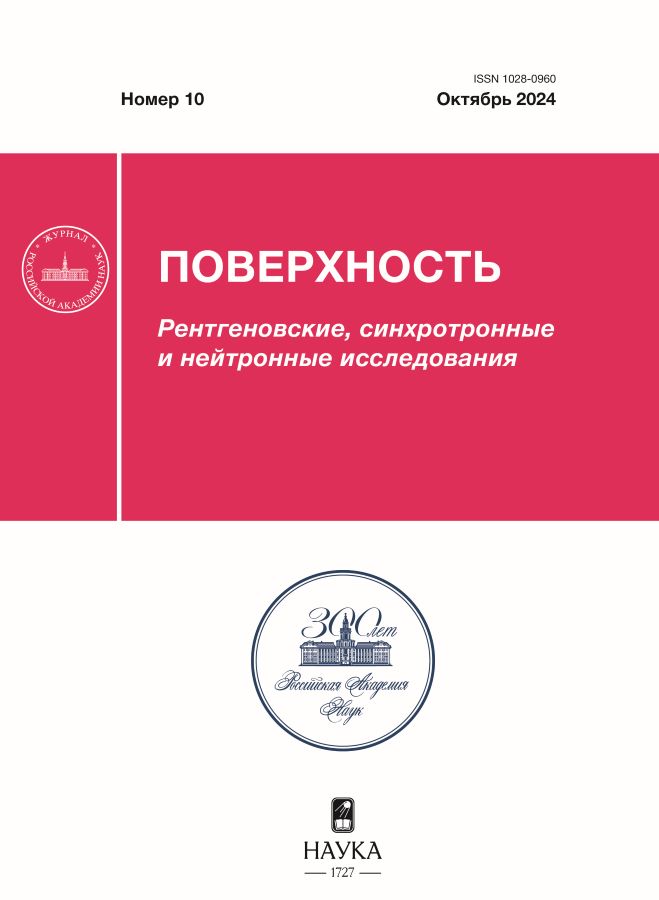Study of silicon dioxide sputtering by a focused gallium ion beam
- Авторлар: Podorozhniy О.V.1, Rumyantsev А.V.1, Volkov R.L.1, Borgardt N.I.1
-
Мекемелер:
- National Research University of Electronic Technology
- Шығарылым: № 10 (2024)
- Беттер: 66-73
- Бөлім: Articles
- URL: https://rjdentistry.com/1028-0960/article/view/664734
- DOI: https://doi.org/10.31857/S1028096024100082
- EDN: https://elibrary.ru/SHGGCG
- ID: 664734
Дәйексөз келтіру
Аннотация
Test structures in the form of rectangular boxes fabricated on thermal silicon dioxide substrates under normal and oblique ion bombardment using the focused ion beam technique were studied by transmission electron microscopy and energy-dispersive X-ray microanalysis. The experimentally obtained depth distribution profiles for gallium atoms, as well as the sputtering yields, were compared with the results of Monte Carlo simulations. Calculations were carried out using standard continuous and discrete-continuous models for the surface binding energy of atoms in silicon dioxide. For the normal incidence of the ion beam, based on minimizing the value of the R-factor, which characterizes the agreement between the calculated and experimental data, the optimal values of the parameters of the discrete-continuous model were found, which turned out to be close to the values used in the continuous model. It is shown that the obtained parameters make it possible to simulate silicon dioxide sputtering with acceptable accuracy at ion beam incidence angles of 15° and 30°. However, at a grazing incidence angle of 80°, significant differences arise between the experimental and calculated profiles of the concentration of gallium atoms implanted in silicon dioxide.
Толық мәтін
Авторлар туралы
О. Podorozhniy
National Research University of Electronic Technology
Хат алмасуға жауапты Автор.
Email: lemi@miee.ru
Ресей, Zelenograd, Moscow
А. Rumyantsev
National Research University of Electronic Technology
Email: lemi@miee.ru
Ресей, Zelenograd, Moscow
R. Volkov
National Research University of Electronic Technology
Email: lemi@miee.ru
Ресей, Zelenograd, Moscow
N. Borgardt
National Research University of Electronic Technology
Email: lemi@miee.ru
Ресей, Zelenograd, Moscow
Әдебиет тізімі
- Sloyan K., Melkonyan H., Dahlem M.S. // Int. J. Adv. Manuf. Technol. 2020. V. 107. P. 4469. https://doi.org./10.1007/s00170-020-05327-5
- Ribeiro R.S.R., Dahal P., Guerreiro A., Jorge P.A.S., Viegas J. // Sci. Rep. 2016. V. 7. P. 4485. https://doi.org./10.1038/s41598-017-04490-2
- Nayak K.P., Kien F.L., Kawai Y., Hakuta K., Nakajima K., Miyazaki H.T., Sugimoto Y. // Opt. Express. 2011. V. 19. № 15. P. 14040. https://doi.org./10.1364/OE.19.014040
- Cabrini S., Liberale C., Cojoc D., Carpentiero A., Prasciolu M., Mora S., Degiorgio V., De Angelis F., Di Fabrizio E. // Microelectron. Eng. 2006. V. 83. P. 804. https://doi.org./10.1016/j.mee.2006.01.247
- Berthelot J., Aćimović S.S., Juan M.L., Kreuzer M.P., Renger J., Quidant R. // Nat. Nanotechnol. 2014. V. 9. P. 295. https://doi.org./10.1038/NNANO.2014.24
- Mayer J., Giannuzzi L.A., Kamino T., Michael J. // MRS Bull. 2007. V. 32. № 5. P. 400. https://doi.org./10.1557/mrs2007.63
- Han Zh., Vehkamäki M., Leskelä M., Ritala M. // Nanotechnology. 2014. V. 25. P. 115302. https://doi.org./10.1088/0957-4484/25/11/115302
- Kim H. B., Hobler G., Steiger A., Lugstein A., Bertagnolli E., Platzgummer E., Loeschner H. // Int. J. Precis. Eng. Manuf. 2011. V. 12. P. 893. https://doi.org./10.1007/s12541-011-0119-3
- Alkemade P.F.A. // Phys. Rev. Lett. 2006. V. 96. P. 107602. https://doi.org./10.1103/PhysRevLett.96.107602
- Kim H.B. // Microelectron. Engin. 2011. V. 88. № 11. P. 3365. https://doi.org./10.1016/j.mee.2011.07.008
- Mahady K.T., Tan S., Greenzweig Y., Raveh A., Rack P.D. // Nanotechnology. 2018. V. 29. № 49. P. 495301. https://doi.org./10.1088/1361-6528/aae183
- Rumyantsev A.V., Borgardt N.I., Volkov R.L., Chaplygin Y.A. // Vacuum. 2022 202. P.111128. https://doi.org./10.1016/j.vacuum.2022.111128
- Seah M.P., Nunney T.S. // J. Phys. D. 2010. V. 43. № 25. P. 253001. https://doi.org./10.1088/0022-3727/43/25/253001
- Duan G., Xing T., Li Y. // AOMATT. SPIE. 2012. V. 8416. P. 585. https://doi.org.10.1117/12.973697
- Mutzke A., Schneider R., Eckstein W., Dohmen R., Schmid K., von Toissaint U., Bandelow G. SDTrimSP Version 6.00 IPP Report 2019-2, 2019. 91 p.
- Бачурин В.И., Кривелевич С.А., Потапов Е.В., Чурилов А.Б // Поверхность. Рентген. синхротр. и нейтрон. исслед. 2007. № 3. С. 19.
- Бачурин В.И., Изюмов М.О., Амиров И.И., Шуваев Н.О. // Изв. РАН. Сер. физ. 2018. Т. 82. № 2. С. 146. https://doi.org.10.7868/S0367676518020035
- Kudriavtsev Y., Villegas A., Godines A., Asomoza R. // Appl. Surf. Sci. 2005. V. 239. № 3–4. P. 273. https://doi.org.10.1016/j.apsusc.2004.06.014
- Румянцев А.В., Подорожний О.В., Волков Р.Л., Боргардт Н.И. // Изв. вузов. Электроника. 2023. Т. 28. № 5. С. 555. https://doi.org.10.24151/1561-5405-2023-28-5-555-568
- Румянцев А.В., Подорожний О.В., Волков Р.Л., Боргардт Н.И. // Изв. вузов. Электроника. 2022. Т. 27. № 4. С. 463. https://doi.org.10.24151/1561-5405-2022-27-4-463-474
- Mutzke A., Bandelow G., Schmid K. News in SDTrimSP Version 5.05, 2015. 46 p.
- El-Kareh B., Hutter L.N. Fundamentals of Semiconductor Processing Technology. New York: Springer Science & Business Media, 1995. 602 p. https://doi.org.10.1007/978-1-4615-2209-6
- Eckstein W. Computer Simulation of Ion-Solid Interactions. Berlin–Heidelberg: Springer, 2013. 296 p. https://doi.org.10.1007/978-3-642-73513-4
- Румянцев А.В., Боргардт Н.И., Волков Р.Л. // Поверхность. Рентген., синхротр. и нейтрон. исслед. 2018. № 6. С. 102. https://doi.org.10.7868/S0207352818060197
- Hofmann S., Thomas III J.H. // J. Vac. Sci. Technol. B. 1983. V. 1. № 1. P. 43. https://doi.org.10.1116/1.582540
Қосымша файлдар












